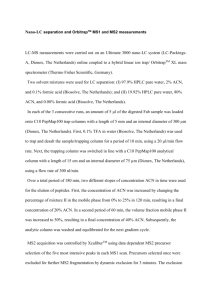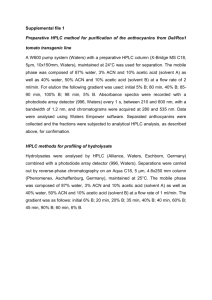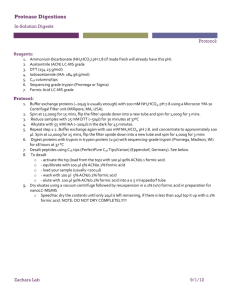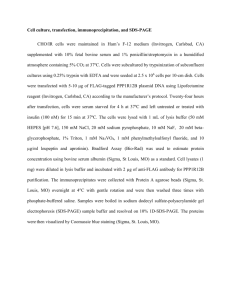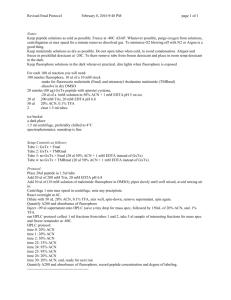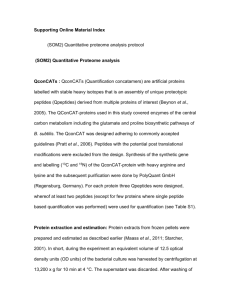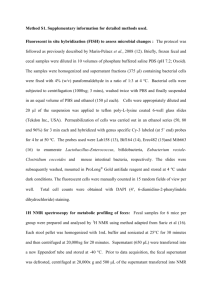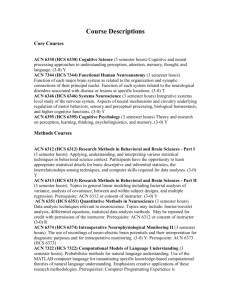tpj12775-sup-0006-MethodsS1
advertisement
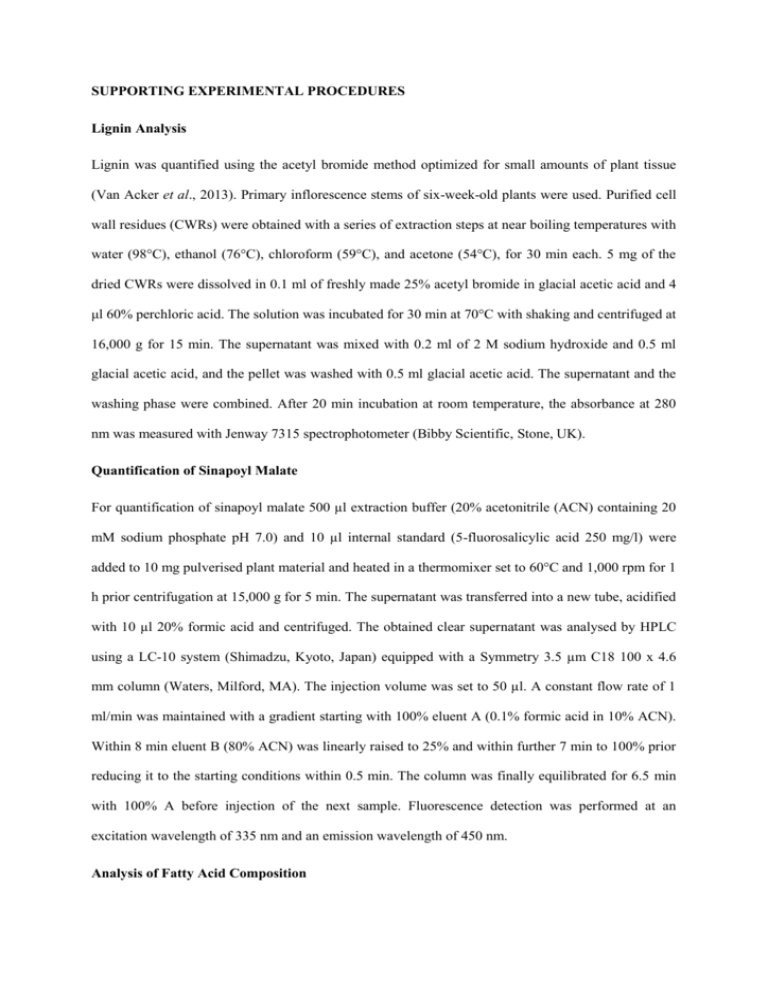
SUPPORTING EXPERIMENTAL PROCEDURES Lignin Analysis Lignin was quantified using the acetyl bromide method optimized for small amounts of plant tissue (Van Acker et al., 2013). Primary inflorescence stems of six-week-old plants were used. Purified cell wall residues (CWRs) were obtained with a series of extraction steps at near boiling temperatures with water (98°C), ethanol (76°C), chloroform (59°C), and acetone (54°C), for 30 min each. 5 mg of the dried CWRs were dissolved in 0.1 ml of freshly made 25% acetyl bromide in glacial acetic acid and 4 μl 60% perchloric acid. The solution was incubated for 30 min at 70°C with shaking and centrifuged at 16,000 g for 15 min. The supernatant was mixed with 0.2 ml of 2 M sodium hydroxide and 0.5 ml glacial acetic acid, and the pellet was washed with 0.5 ml glacial acetic acid. The supernatant and the washing phase were combined. After 20 min incubation at room temperature, the absorbance at 280 nm was measured with Jenway 7315 spectrophotometer (Bibby Scientific, Stone, UK). Quantification of Sinapoyl Malate For quantification of sinapoyl malate 500 µl extraction buffer (20% acetonitrile (ACN) containing 20 mM sodium phosphate pH 7.0) and 10 µl internal standard (5-fluorosalicylic acid 250 mg/l) were added to 10 mg pulverised plant material and heated in a thermomixer set to 60°C and 1,000 rpm for 1 h prior centrifugation at 15,000 g for 5 min. The supernatant was transferred into a new tube, acidified with 10 µl 20% formic acid and centrifuged. The obtained clear supernatant was analysed by HPLC using a LC-10 system (Shimadzu, Kyoto, Japan) equipped with a Symmetry 3.5 µm C18 100 x 4.6 mm column (Waters, Milford, MA). The injection volume was set to 50 µl. A constant flow rate of 1 ml/min was maintained with a gradient starting with 100% eluent A (0.1% formic acid in 10% ACN). Within 8 min eluent B (80% ACN) was linearly raised to 25% and within further 7 min to 100% prior reducing it to the starting conditions within 0.5 min. The column was finally equilibrated for 6.5 min with 100% A before injection of the next sample. Fluorescence detection was performed at an excitation wavelength of 335 nm and an emission wavelength of 450 nm. Analysis of Fatty Acid Composition Quantification of fatty acids was adapted from (Durst et al., 1975). In brief, 20 mg of finely ground plant material were extracted with 300 µl of a 9/1 mixture of 96% ethanol and 3 M aqueous potassium hydroxide at 60°C over night. On the next day the mixture was acidified with 400 µl 0.5 M HCl and extracted with 500 µl n-hexane. The organic phase was collected and evaporated in the vacuum. The residue was treated with 200 µl freshly prepared derivatisation reagent (1 mg/ml 4-bromophenacyl bromide and 0.2 mg/ml 18-crown-6 dissolved in pure ACN) and approximately 1 mg K2CO3 at 60°C for 30 min. 25 µl of the supernatant was directly injected into the HPLC system equipped with a LiChrospher 60 RP-select B 5 µm 125x4 mm column. Elution was performed at a flow rate of 1 ml/min with a gradient starting with 20% A (1 mM acetic acid in 10% ACN) and 80% B (1 mM acetic acid in 100% ACN). The concentration of B was linearly raised to 85% after 8 min and finally to 94% after another 7 min. Subsequently, B was decreased to the starting conditions within 0.5 min and the column equilibrated for 6.5 min prior injection of the next sample. The absorbance at 260 nm was recorded. Quantification of Glucose, Fructose, Sucrose and Starch Soluble sugars were extracted from 30 mg plant material with 1 ml extraction buffer (1% pyridine in water). The mixture was spiked with 20 µl of xylose 500 mg/l as internal standard. Extraction was performed at 80 °C for 30 min in a thermomixer set to 800 rpm. The extract was centrifuged for 5 min at 15,000 g and the clear supernatant evaporated in the vacuum to dryness. 100 µl derivatisation reagent (benzoyl chloride/pyridine = 1/9 v/v) was added to the residue for benzoylation of the sugars and incubated at 4°C overnight. The surplus of the reagent was destroyed by addition of 10 µl water and incubation at room temperature for 30 min prior addition of 800 µl toluene and incubation for further 30 min. The reaction mixture was now subsequently washed with 800 µl 2 M phosphoric acid, 800 µl 0.5 M sodium phosphate buffer pH 7.0 and finally 800 µl water prior evaporating it in the vacuum to dryness. The residue was dissolved in 80 % ACN, centrifuged and injected into the HPLC system equipped with a nucleosil C18 100-5 200 x 4.6 mm column. Elution started with 35% eluent A (10% ACN) and 65% eluent B (100% ACN). Within 15 min eluent B was linearly increased to 70% and within further 21 min to 100% and then kept at 100% for another 3 minutes prior reducing it to the starting conditions within 1 min. The column was finally equilibrated for 5 min with 35% A and 65% B before the next sample was injected. For quantification the UV absorbance was recorded at 230 nm. Starch was quantified as previously described (Rose et al., 1991). Leaves of three-week-old plants were ground in liquid nitrogen and extracted three times with 80% ethanol at 75°C. The pellet was dried and heated at 50°C with 0.1 N NaOH for 30 min, then 900 µl 0.1 N acetic acid was added to adjust the pH to 5.1. To each sample 200 U of α-amylase and 2 U of amyloglucosidase were added and incubated for 2 hrs at 37°C following 20 min incubation at 50-55°C. Glucose in the samples was analyzed with glucose oxidase/peroxidase/o-dianisidine solutuion. Salicylic Acid Measurements Total and free salicylic acid was measured as described previously (Rozhon et al., 2005) except that a Nucleodur 100-5 NH2 125x4 mm column and an eluent consisting of 8.5% ACN containing 25 mM formic acid set with NaOH to pH 4.0 were used. SUPPORTING REFERENCES Durst, H.D., Milano, M., Kikta, E.J. Jr., Connelly, S.A. and Grushka, E. (1975) Phenacyl esters of fatty acids via crown ether catalysts for enhanced ultraviolet detection in liquid chromatography. Anal Chem., 47, 1797-1801. Rose, R., Rose, C.L., Omi, S.K., Forry, K.R., Durall, D.M. and Bigg, W.L. (1991) Starch Determination by Perchloric-Acid Vs Enzymes - Evaluating the Accuracy and Precision of 6 Colorimetric Methods. J Agric Food Chem., 39, 2–11. Rozhon, W., Petutschnig, E., Wrzaczek, M. and Jonak, C. (2005) Quantification of free and total salicylic acid in plants by solid-phase extraction and isocratic high-performance anion-exchange chromatography. Anal Bioanal Chem., 382, 1620-7. Van Acker, R., Vanholme, R., Storme, V., Mortimer, J.C., Dupree, P. and Boerjan, W. (2013) Lignin biosynthesis perturbations affect secondary cell wall composition and saccharification yield in Arabidopsis thaliana. Biotechnol Biofuels 26, 46.
